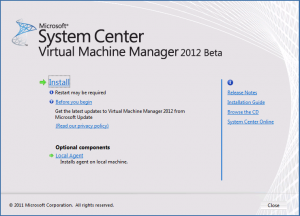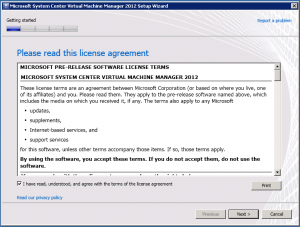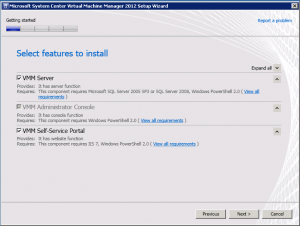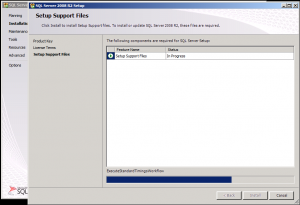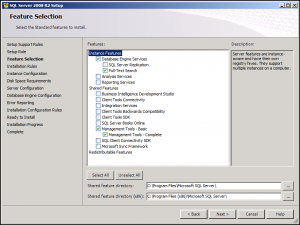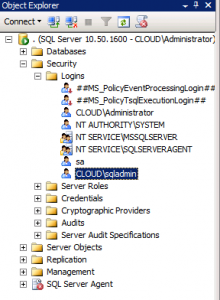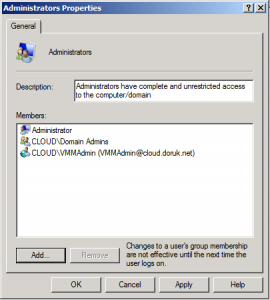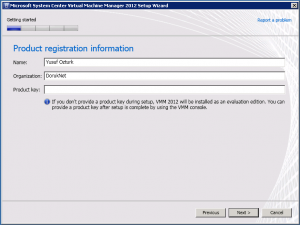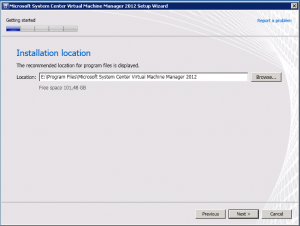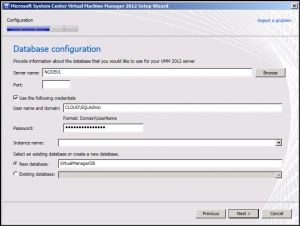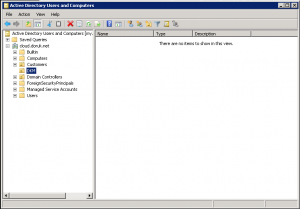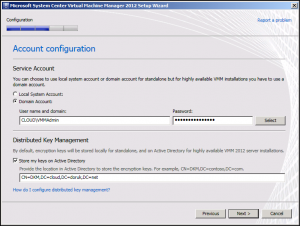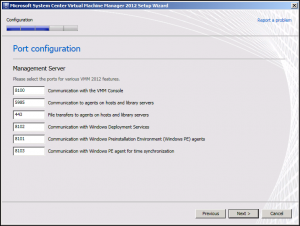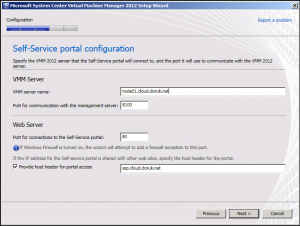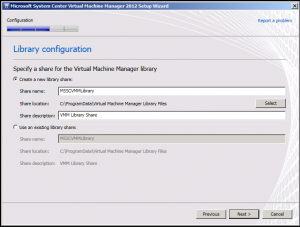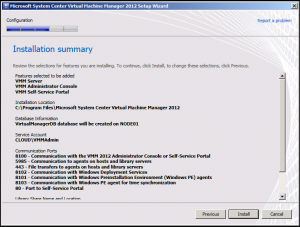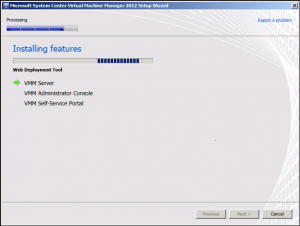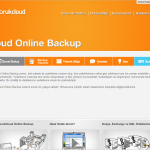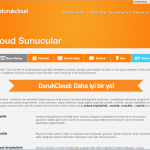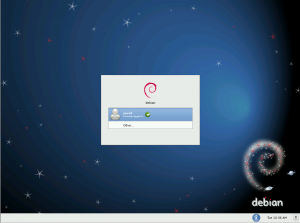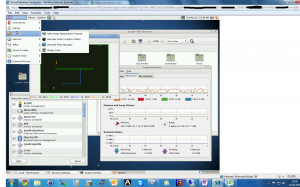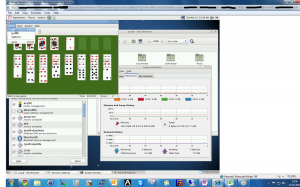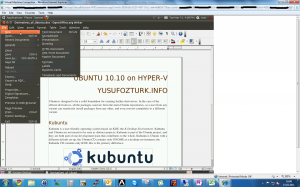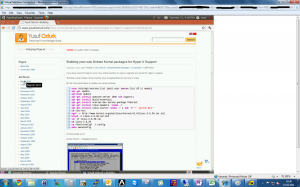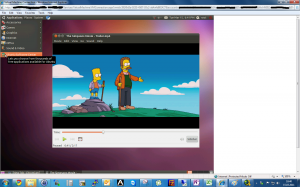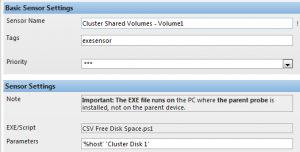
Categories

Sponsors


Archive
 Blogroll 
Badges


Community

|
Posted in Virtual Machine Manager | 2 Comments | 8,931 views | 23/03/2011 19:41
Yesterday, Microsoft released beta version of System Center Virtual Machine Manager 2012 (vNext). In this series, you will see details of SCVMM 2012 if you haven’t seen already. In Part1, I start with installation. I installed Windows Server 2008 R2 SP1 with latest updates. After download, if you start setup.exe, you will see new welcome screen of SCVMM. Next step, you have to agree license agreement. Next step, you will see features and software requirements. Let’s check requirements of SCVMM 2012: * Windows Server 2008 R2 (SP1 or earlier)
* Windows Remote Management (WinRM) 2.0 * At least Microsoft .NET Framework 3.5 Service Pack 1 (SP1) * Windows Automated Installation Kit (AIK) for Windows 7 * SQL Server 2008 R2 or SQL Server 2008 SP2 You need to download WAIK from Windows Download. You can download it from: You don’t have to install .Net Framework. If you don’t have it, SCVMM will install for you. You should install SQL as Standard or Enterprise edition for SCVMM 2012. Web or Express edition is not supported. I attached a SQL Server 2008 R2 Enterprise Edition ISO to SCVMM server. Install SQL Server as default configuration. I choose only basic features of MSSQL like Database Engine and Management Tools.. After MSSQL installation, I’ll two different admin users for MSSQL and SCVMM. SCVMM 2012 requires domain account for high availability option. You should give SQL Access to your new SQL admin. Also you should add your new SCVMM admin to the local Administrators group. After setup of requirements, lets continue with SCVMM installation. Next step, you should choose a location. After that, you’ll see SQL configuration step. Type your server, username and choose “New Database” option. After this step, you will see Account Configuration. First, I create an OU for DKM (Distributed Key Management) and type it in this step. You should use Active Directory integration for high availability option. You should also use domain account for SCVMM 2012 for high availability. Then you will see port configuration of SCVMM 2012. Next step, you will see Self Service Portal configuration. Then you will see Library Share configuration. and finally we see installation summary. You can start installation by clicking “Install” button. After that you will see installation steps. Wolaa! :) Now we can open SCVMM 2012 console and use vNext.
Posted in Data Protection Manager | No Comment | 8,508 views | 23/03/2011 08:42
You may get error when you backup Exchange 2007 database on Data Protection Manager 2010. Affected area: First Storage Group
Occurred since: 23.03.2011 01:30:30 Description: Recovery point creation jobs for Storage group First Storage Group on Spartacus have been failing. The number of failed recovery point creation jobs = 28. If the datasource protected is SharePoint, then click on the Error Details to view the list of databases for which recovery point creation failed. (ID 3114) DPM encountered a retryable VSS error. (ID 30112 Details: VssError:The writer experienced a transient error. If the backup process is retried, the error may not reoccur. (0x800423F3)) More information Recommended action: Check the Application Event Log on Spartacus for the cause of the failure. Fix the cause and retry the operation. For more information on this error, go to http://go.microsoft.com/fwlink/?LinkId=132612. Create a recovery point… Resolution: To dismiss the alert, click below Inactivate alert To Resolve this issue, go to Exchange server and disable “Circular logging” from mailbox database settings.
Posted in Hayattan | 1 Comment | 4,977 views | 18/03/2011 12:58
DorukCloud, kullanılan fiziksel alan ve enerjinin azaltılabilmesi için optimize edilmiş modüler tasarıma sahip ve kullanılan her bir donanımsal bileşenin yedekli olduğu HP Blade mimarisini tercih etmektedir. Sanallaştırma olarak Microsoft Hyper-V mimarisini kullanılmaktadır. Tüm sanal sunucular NTFS dosya sisteminden farklı olarak CSV (Cluster Shared Volumes) dosya sistemi üzerinde çalıştırılarak, Microsoft Clustering’in sunduğu avantajlarla yüksek erişilebilirlik elde edilmektedir. Sanal makineler, üzerinde bulundukları fiziksel makinelerin kullanılabilir bellek ve işlemci limitlerine ulaşıldığında, Live Migration teknolojisi sayesinde, hiç bir erişim kesintisi yaşamadan, en uygun durumdaki başka bir fiziksel sunucuya aktarılması sağlanır. Bu aktarma işlemi, System Center Operations Manager kontrolünde, System Center Virtual Machine Manager’ın Intelligent Placement özelliği ile yapılmaktadır. DorukCloud’un web sitesine ulaşmak ve ayrıntılı bilgi almak için aşağıdaki bağlantıya tıklayabilirsiniz. Site üzerinden satışlar şuan itibariyle aktif durumdadır.
Posted in Virtual Machine Manager | 2 Comments | 6,331 views | 17/03/2011 16:31
Hi everyone, I get mails from blog visitors about Linux support and benchmark results. Thanks to everyone who sends me email and share their ideas. I’m trying to reply every mail but I thought that writing on blog about that could be more easy. First of all, Microsoft supports only: * SUSE Linux Enterprise Server 10 with Service Pack 3 (x86 Edition or x64 Edition)
* SUSE Linux Enterprise Server 11 (x86 Edition or x64 Edition) * Red Hat Enterprise Linux (RHEL) 5.2, 5.3 , 5.4 and 5.5 (x86 Edition or x64 Edition) That means, If you use Centos, Debian or Ubuntu etc. on Hyper-V, You won’t get any support from Microsoft. So I recommend you to never use these unsupported distros in production. If you want to use them, use with your own risk. You may get errors or warnings when you use them. But let’s pass them and think about unsupported distros. If you want to use Ubuntu on Hyper-V, what should you do? We have a solution. Hyper-V Linux Integration codes added to Linux kernel last year. So what we do is, enabling that modules from kernel. There were 2 major improvements on kernel. Kernel 2.6.32: * Synthetic Ethernet Support
* Fast boot * Enlightened IDE support Kernel 2.6.35: * SMP (up to 4 virtual CPU support)
* Timesync * Integrated Shutdown So If you install a Linux distribution which uses kernel 2.6.32, you will get Fast Boot and Synthetic Ethernet support but you won’t get 4 vcpu support, timesync or even integrated shutdown. But if you install a distro which uses kernel 2.6.35, you will see the differences. You can reboot your server with shutdown button and you can get good performance from 4 virtual CPU. So if I give examples; with Debian 6 (kernel 2.6.32-5): * Fast boot
* Synthetic Ethernet with Ubuntu 10.10 (kernel 2.6.35-22):
* Fast boot
* Synthetic Ethernet * 4 virtual CPU * Integrated Shutdown So what happens if you give 4 vCpu to Debian (2.6.32)? Debian sees that 4 vCpu and boots without warning. But seeing 4 vCpu doesn’t mean Linux will use all processors at the same time. Of course 4 vCpu has positive effects on virtual machine but you should install integration services if you want to get more.
Posted in Virtual Machine Manager | No Comment | 13,298 views | 16/03/2011 07:11
I did performance tests on several Linux distributions to see their performance on Hyper-V. As you see, Debian and Ubuntu have almost same results. Debian looks really promising. I never used Hyper-V Linux integration services on them because this is an article about real results. If you install a clean Debian, you will get almost same results. I used Unix Bench 5.1.3 for Benchmark tests. You can download and try on your own environment: In my tests, only Ubuntu gave warning on boots. Actually it just a warning but i want to write here, so maybe you know what causes that. SMBus Base Address Uninitialized – Upgrade Bios or use force_addr=0xaddr
As I know, this is a Ubuntu bug and they’ll fix it in next version. So it’s good to wait next version to correct this issue. Also you checked reboot durations of distros? Centos still uses 2.6.18 and because of that, reboot takes so long. It seems new kernel provides fast reboot. We already know that it’s feature of Hyper-V drivers. Probably with Centos 6, we will reboot Centos in 20 secs like Fedora.
Posted in Virtual Machine Manager | 2 Comments | 37,903 views | 15/03/2011 19:02
Hello everyone, I spend lots of my time to improve Linux performance on Hyper-V. If you read my previous post, I posted lots of bechmark results and custom kernels for Linux distributions. I worked on Linux Servers whole time. But what about Linux workstations? As you know about that, you can’t use mouse because Hyper-V does not support mouse integration for Linux guests. Citrix released mouse integration called Satori. Satori is a mouse driver for Linux guests. You can reach Satori Project webpage from the link below: But you have to install Hyper-V LIC on Linux guests before install Satori. So what about Debian and other Linux guests? I mean, you have to install Hyper-V LIC on Hyper-V, if even you can, that may cause performance issues and problems on Debian. So I looked for another solution for Linux workstations. Microsoft recently released Dynamic Datacenter Toolkit. That DDC has some cool features like ActiveX RDP Support. Via ActiveX RDP, you can connect your virtual machines on your web browser (actually only with Internet Explorer). If you have Windows 7 SP1, you can control mouse. Let me show you some examples: Debian 6: Ubuntu 10.10: All you need to use ActiveX RDP: Mouse integration is only available with Windows 7 SP1.
Posted in Virtual Machine Manager, Windows Powershell | 4 Comments | 17,023 views | 08/03/2011 15:04
You can not monitor CSV Free Disk Space with PRTG by default. You should use custom scripts to do that. So I decided to write a Powershell script for that. But instead of using WMI in Powershell, using Powershell commands with Remote Powershell is a lot easier. Also this is an example for you about how to execute your own Powershell scripts on remote servers. Also this is a great example for Remote Powershell functionality if you are not familiar with it. First of all, you need my PS1 script for monitoring:
Now save as this script as “CSV Free Disk Space.ps1” and copy it to the “C:\Program Files (x86)\PRTG Network Monitor\Custom Sensors\EXE” folder on the PRTG -Probe- server. Only one note, you should change Domain and Password info in the script. You should write your Administrator name as “CONTOSO\Administrator”. You should write your password as clean text but I’ll work about that to find a way to encrypt it. Just change “PASSWORD_HERE” line and “DOMAN\Administrator” line in the script. Before adding sensor on to PRTG, you should configure Remote Powershell functionality on PRTG server and on one of the Hyper-V Cluster Host. First, go to PRTG host and execute on Powershell:
One important note. If you use Windows Server 2008 R2 or Windows x64 versions, you should execute commands on both x86 version of Powershell and x64 version of Powershell. x86 path: C:\Windows\System32\WindowsPowerShell\v1.0\powershell.exe
x64 path: C:\Windows\SysWOW64\WindowsPowerShell\v1.0\powershell.exe Also you may need to disable UAC to execute Remote Powershell commands! Then go to Hyper-V Cluster Host and execute:
Now go to the PRTG and create a custom sensor for Hyper-V Cluster Host. Only one important thing is “Parameters”. You should write exactly same things there:
If you have more than one CSV disk, just add them as a new sensor and parameters should be:
After a few minutes, PRTG will start showing Free Space information. Actually I added “Used Space” to the PRTG. You can change it as “Free Space” if you want. There are lines in the script:
Just remove the last line like here:
I hope this will help you to monitor your environment. |










